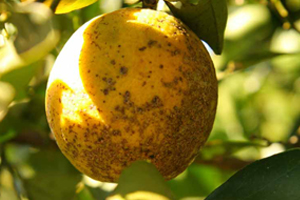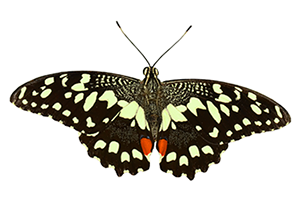While limiting the spread of the Asian citrus psyllid and Huanglongbing are the highest priority for the California citrus industry and the Citrus Pest & Disease Prevention Program, the program continually monitors for a number of threats to the industry and has recently detected sweet orange scab (SOS) in new areas of the state. Additionally, an unofficial Lime Swallowtail Butterfly (LSB) sample was identified from Los Angeles County and several LSB sightings have been uploaded onto the iNaturalist application, including sightings in Los Angeles and San Luis Obispo counties.
SOS is a cosmetic fungal disease that impacts the marketability of the fruit and effects all citrus, not just oranges. SOS is caused by the fungus Elsinöe australis, which is dispersed by water. You can recognize SOS by the scab-like lesions on fruit, and less frequently on leaves and twigs. SOS can cause premature fruit drop and stunt young nursery trees and new field plantings but has little impact on fruit quality.
A positive detection of SOS was found during a commodity survey on the west side of Riverside County, the fourth detection in California within the last year and a half. To help protect citrus from SOS, growers and packinghouses within five miles from an SOS detection, and packinghouses throughout the state receiving fruit from groves within five miles from an SOS detection, are currently required to follow the below measures:
Per the Citrus Pest & Disease Prevention Committee’s direction, CDFA is also reviewing SOS impacts and analyzing the need to establish SOS interior quarantine regulations. Currently the program regulates areas within a five-mile radius from each SOS detection, following the United States Department of Agriculture’s quarantine protocols.
Working hand in hand with growers, CDFA is exploring the rulemaking process to create state interior quarantines, which will avoid a broader statewide quarantine that would be more burdensome to the industry.
More information will be shared throughout the process, so stay tuned to Citrus Insider for the latest updates.
There was one unofficial detection of LSB in Los Angeles and several reported sightings in Los Angeles and in San Luis Obispo counties.
LSB in the larval stage eat citrus leaves and have been very damaging to nursery stock in other parts of the world. The larva looks similar to bird guano before maturing into green caterpillars. As butterflies, they are largely black with irregular yellow spots on the outer wings.

Fruit lesions from sweet orange scab. Photo credit: USDA Animal and Plant Health Inspection Service.

Dorsal view of adult Lime Swallowtail Butterfly.
CDFA Monitoring to Protect California Citrus
CDFA staff will regularly monitor for LSB and SOS when doing the surveys that are helping keep California citrus thriving.
